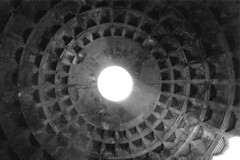Ah, subjectivity, the bane of architecture students everywhere. I have been intrigued by the notion that modernism only allows the truly talented and inventive to reach the level of “good”. I have felt for a while now that contemporary architecture has defined success out of its routine reach. The push for relentless innovation and formal invention has been directly responsible for many “good” architects failing to achieve what modernism has defined as “great” (and therefore taking on the unfortunate and unwarranted mantle of a failed visionary).
I don’t think that the architects of the past were any better than the architects of today. I do however feel that our predecessors were given what we largely lack today: a mastery of the architectural solutions that we already know to be successful and a public that valued stable, time-tested architectural solutions. Given these two things, architects were prepared to provide the public with a nearly endless stream of “good” architecture. Every once in a while a visionary would appear and successfully introduce something incredibly novel or inventive that would then provide a new tool for the community of architects. Today is a different story altogether. We have defined “good” architecture as being innovative and new, creating a huge building catalogue of failed social interventions and innovations undertaken by “good”, but less than visionary, architects.
You can see this same process at work in the great Renaissance schools of painting. Artists were taught the techniques of visionaries in the hopes of producing many people who could create beautiful art. Unfortunately our modern cult of the lone artistic visionary has produced an army of talented people trying in vain to be the latest and greatest thing at the expense of true beauty and cultural precedent. We have also so successfully instilled the principle that imitation is the greatest taboo of our art that students are scared to cite so much as a precedent for any project whatsoever. Once again, if we could just get over ourselves maybe we could get back to creating “good” art and architecture.
Thinking about this has helped me immensely to reconcile some things in my head. I realize now why I have such an admiration for some truly great works of modernism while at the same time harboring a newfound respect for the classical tradition and those attempting to re-introduce it into our architectural heritage. The crux is this: there are great artists and architects out there that produce great work that is then viewed with an awe that prevents it from being replicated and absorbed into the greater whole. We are so scared of copying greatness, of being unoriginal, that we will continue to produce crap in the unending quest for the greatness we have already been shown numerous times…welcome to Groundhog Day!
13 September, 2007
Subscribe to:
Post Comments (Atom)

2 comments:
Your thinking on contemporary art is uncannily like my own. I have an MFA in painting, and the experience sounds similar to your background in architecture.
There was just a complete, clean break with the entire living tradition of art up until the nineteenth century. That stuff was for museums, not for "serious" living artists. The thing was to be "original", which is a shame. Being good or bad was not even a question. Those categories didn't exist.
All the best things in life are unoriginal. Beer (okay, wine might be more apt), cheese, bread and sex are not only wonderful experiences in themselves, they are universal - extending not only to the entire living family of man, but backward in time to encompass our ancestors. They tie us together. The forced originality of modernism fractures and divides.
Tim,
I certainly agree. Architecture presents its own set of difficulties because it is a public art, there is always the problem of dealing with the context of a building. The mentality is the same as in art however. Architecture should never be solely about singular vision, it should be about vision working with precedent and context.
Thanks for reading and
I'll look forward to getting a perspective from the art world on many of these issues.
Post a Comment